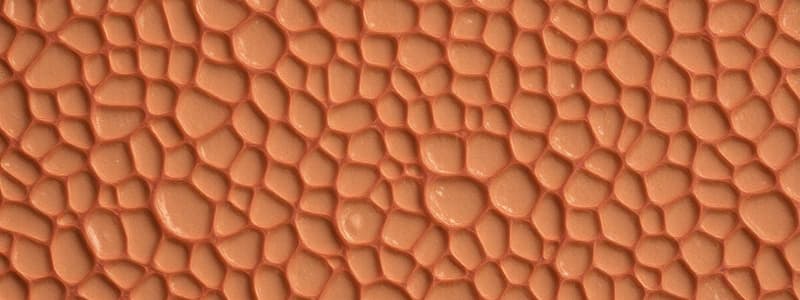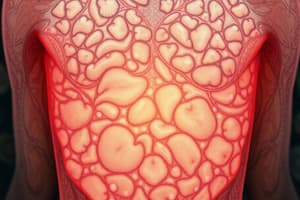Podcast
Questions and Answers
What characteristic distinguishes epithelial tissue from other tissue types?
What characteristic distinguishes epithelial tissue from other tissue types?
- Presence of large amounts of extracellular matrix
- Closely packed cells organized in layers (correct)
- Highly vascular with many blood vessels
- Contains a high density of muscle fibers
Which of the following best describes the location of epithelial tissue in the body?
Which of the following best describes the location of epithelial tissue in the body?
- Surrounding muscles and organs
- Covering surfaces and lining cavities (correct)
- In the bloodstream distributing nutrients
- Filling spaces between other tissues
How do epithelial tissues differ from connective tissues?
How do epithelial tissues differ from connective tissues?
- Epithelial tissues have a high amount of extracellular matrix
- Epithelial cells are avascular while connective tissues have blood vessels (correct)
- Epithelial tissues are not specialized for any specific function
- Connective tissues only consist of a single layer of cells
Which of the following statements is NOT true about epithelial cells?
Which of the following statements is NOT true about epithelial cells?
What is a common feature of epithelial tissues regarding their composition?
What is a common feature of epithelial tissues regarding their composition?
What is a primary characteristic of epithelial tissue?
What is a primary characteristic of epithelial tissue?
Which type of epithelium is characterized by a single layer of flattened cells?
Which type of epithelium is characterized by a single layer of flattened cells?
What role does the basement membrane play in relation to epithelial tissue?
What role does the basement membrane play in relation to epithelial tissue?
What is a common function of simple cuboidal epithelium?
What is a common function of simple cuboidal epithelium?
Which characteristic distinguishes transitional epithelium from other epithelial types?
Which characteristic distinguishes transitional epithelium from other epithelial types?
What is a key characteristic of pseudostratified columnar epithelium?
What is a key characteristic of pseudostratified columnar epithelium?
What distinguishes keratinized stratified squamous epithelium from non-keratinized?
What distinguishes keratinized stratified squamous epithelium from non-keratinized?
Which statement correctly describes transitional epithelium?
Which statement correctly describes transitional epithelium?
What characterizes stratified cuboidal epithelium?
What characterizes stratified cuboidal epithelium?
What is the primary function of stratified columnar epithelium?
What is the primary function of stratified columnar epithelium?
What is the primary role of desmosomes and tight junctions in epithelial cells?
What is the primary role of desmosomes and tight junctions in epithelial cells?
Which type of epithelium allows the urinary bladder to stretch without compromising its function?
Which type of epithelium allows the urinary bladder to stretch without compromising its function?
What distinguishes epithelial cells from endothelial cells?
What distinguishes epithelial cells from endothelial cells?
What process allows substances to be absorbed selectively through epithelial cells?
What process allows substances to be absorbed selectively through epithelial cells?
Which of the following is NOT a function of epithelium?
Which of the following is NOT a function of epithelium?
How does secretion differ from excretion in epithelial cells?
How does secretion differ from excretion in epithelial cells?
What role do cilia play in certain epithelial cells?
What role do cilia play in certain epithelial cells?
Which function of epithelium involves the lining of body cavities and organs?
Which function of epithelium involves the lining of body cavities and organs?
What type of membrane lines the body cavities that are open to the external environment?
What type of membrane lines the body cavities that are open to the external environment?
Which fluid is primarily composed of 95% water and secreted by mucous glands?
Which fluid is primarily composed of 95% water and secreted by mucous glands?
What are the two layers that make up the serous membrane?
What are the two layers that make up the serous membrane?
What is the primary function of synovial fluid in joints?
What is the primary function of synovial fluid in joints?
What type of epithelial membrane is the cutaneous membrane classified as?
What type of epithelial membrane is the cutaneous membrane classified as?
What is a key characteristic of the mucous membrane?
What is a key characteristic of the mucous membrane?
What substance does fibroblasts release into the joint cavity?
What substance does fibroblasts release into the joint cavity?
Which membrane serves as a protective covering for the body against external factors?
Which membrane serves as a protective covering for the body against external factors?
Flashcards are hidden until you start studying
Study Notes
Epithelial Tissue
- Epithelial tissue covers the entire body surface
- Closely packed cells arranged in one or more layers
- Specialized to form the lining of internal and external body surfaces
- One of the four main tissue types in the human body, alongside muscle, nerve, and connective tissue
Epithelial Tissue Characteristics
- Avascular: No capillaries reside within epithelial tissue
- Sensory: Endings of neurons are present
- Gliding surface layer: Cells slough off and replace dead cells, maintaining a barrier
- Transitional: Multi-layered epithelia stretch, allowing for changes in organ size
- Tight barrier: Desmosomes, hemi-desmosomes, and tight junctions hold cells together
- Different from endothelial cells: Endothelial cells line internal structures, not exposed to the outside
Epithelial Tissue Functions
- Secretion: Movement of material from one point to another
- Absorption: Taking in substances like liquids, gases, and secreted chemicals
- Protection: Covering inner and outer linings of cavities and organs
- Transport: Movement of substances across the cell membrane
- Sensation: Nerve endings provide signals for sensory experiences
- Movement: Cilia aid in moving substances through a sweeping motion
Epithelial Tissue Classifications
- Simple Epithelium: One layer of cells
- Squamous: Flattened cells facilitating material transfer
- Cuboidal: Cuboidal cells involved in absorption, secretion, and excretion
- Columnar: Taller than wide cells associated with absorption and secretion
- Stratified Epithelium: Multiple layers of cells
- Squamous: Flattened cells providing protection from abrasion, can be keratinized or non-keratinized
- Cuboidal: Multiple layers with a cuboidal outermost layer, limited distribution
- Columnar: Multiple layers with a columnar top layer, primarily for protection
- Pseudostratified Columnar Epithelium: Appears stratified due to nuclei at different levels, all cells touch the basement membrane
Membranes
- Sheets of tissue composed of cells
- Cover or line internal structures or cavities
Membrane Types
- Mucous Membrane: Lines body cavities open to the external environment
- Contains mucous cells
- Protective function
- Secretes mucous to keep the membrane moist
- Serous Membrane: Lines body cavities not open to the external environment
- Composed of mesoderm-derived epithelium
- Two layers: Parietal (outer) and Visceral (inner)
- Serous fluid lubricates
- Synovial Membrane: Lines freely movable joint cavities
- Fibroblasts release hyaluronan
- Hyaluronan traps water to form synovial fluid
- Nourishes cartilage
- Cutaneous Membrane: Stratified squamous epithelial membrane
- Rests on connective tissue
- Covered with dead keratinized cells for protection
- Also known as skin
Studying That Suits You
Use AI to generate personalized quizzes and flashcards to suit your learning preferences.




